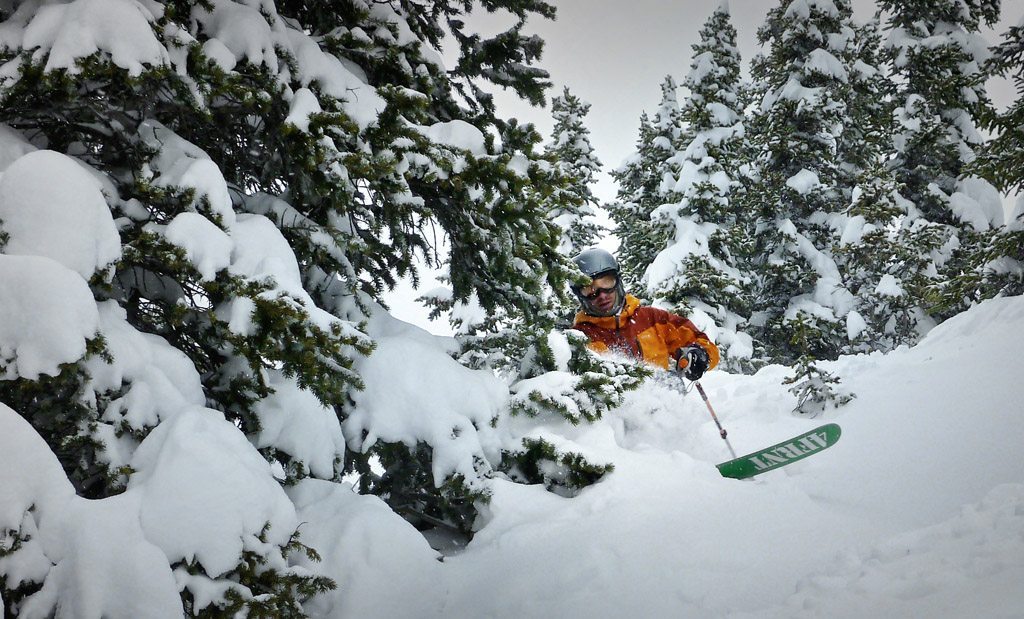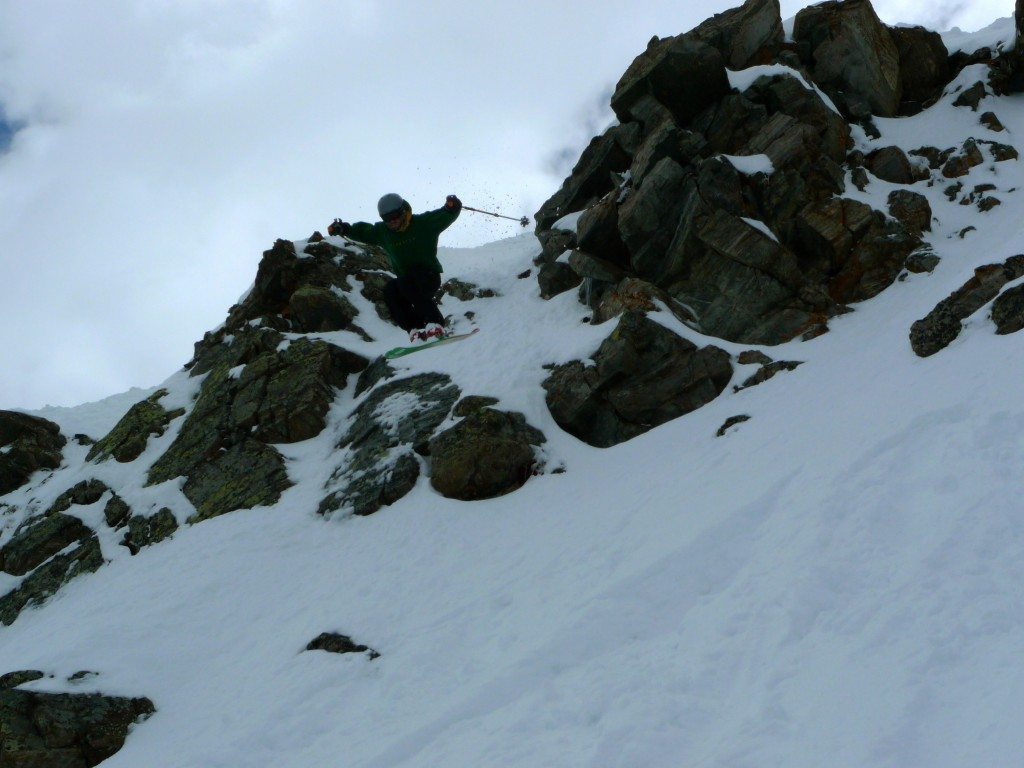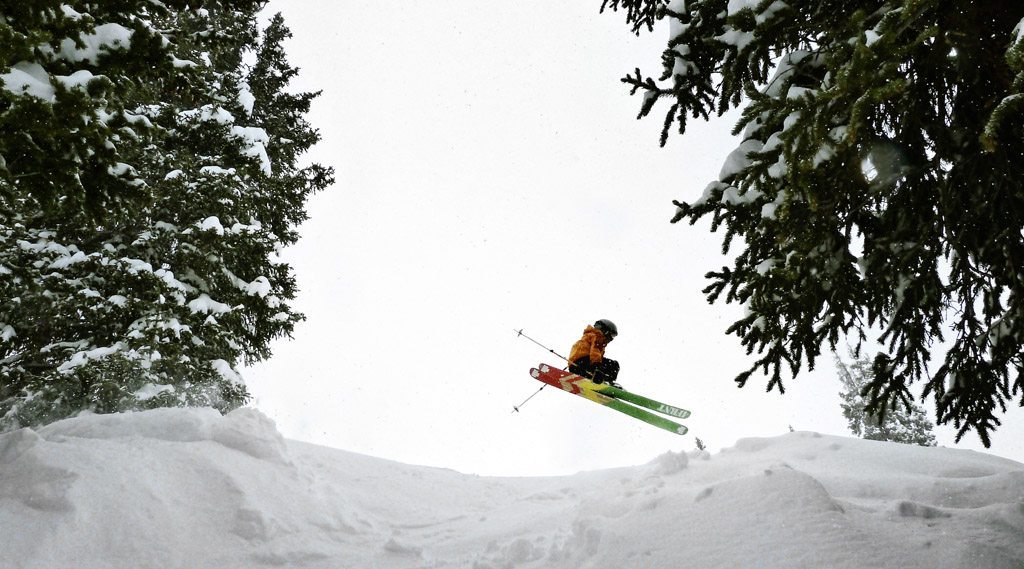
Ski: 2013-2014 4FRNT CRJ, 180cm
Dimensions (mm): 126-115-124
Turn Radius: 27 meters
Actual Tip to Tail Length (straight tape pull): 177.8cm
Boots / Bindings: Scarpa T-Race / Black Diamond O1
Mount Location: True center
Test Location: Arapahoe Basin; Loveland Pass; Alta Ski Area; Snowbird
Days Skied: 6
[Editor’s Note: Our review was conducted on the 11/12 CRJ, which was unchanged for 12/13 and 13/14, except for the graphics.]
Just before leaving Salt Lake City for BLISTER’s Colorado resort, Arapahoe Basin, Jonathan Ellsworth and I were in 4FRNT’s headquarters, standing before a wall of their 2011-2012 skis. As I took in the array of handmade skis mounted with 4FRNT’s signature alpine bindings, I finally saw what I’d been looking for: a pair of CRJs with Black Diamond O1 telemark bindings.
The CRJ is subtle version of a fun shape design: it has a rockered tip and tail, regular camber underfoot, and normal side cut. Except for the significant amount of tip and tail rocker, all of the dimensions are very subtle. I realize this sounds odd considering the 126-115-124mm measurements, but when I had them on my feet they appeared to have a reverse side cut, mostly due to the skinny tips and tail. The ski has a wood core that has been layered with fiberglass and ABS sidewalls, resulting in a ski built for big mountain powder. The 11/12 design is unchanged from last year’s, which was a culmination of four prototypes that CR designed, tested, and finally approved.
The CRJ was not designed for the masses; rather, it’s the embodiment of an athlete’s style, passion, and art. When you put on a pair, you can begin to get a sense of CR’s objectives and his approach to the mountain. Of course, you could arguably say this about many pro model skis, but the fact that CR credited the design with helping him ski again after his stint in the hospital says a lot about the way this ski performs.

Jonathan, BLISTER reviewer Andrew Gregovich, and I stood at the bottom of the Black Mountain Express chair after a long car ride from Utah to A-Basin. My first reaction to being upright on the CRJ was that they were extremely stable. As we rode up our first chair I could tell that the swing weight of the ski was very even, and I felt the strong urge to jib. Cody Barnhill (4FRNT athlete and ski builder) would later explain to me that this combination came from a ski that was designed to “spin like a dreidel and stomp like you’re on a pair of 210’s.”
As we got off the chair and skied down the well-groomed Wrangler to Lenawee Mountain Lift, I was not so pleasantly surprised by how much I had to focus to put the ski on edge. It just did not want to carve. I thought it might be an issue with the binding as I squashed my pinky toe as hard as I could into my turn. Finally, the ski caught my drift and got on edge. And then, I felt the tails of the CRJ support me in a way I hadn’t felt on a ski….
We stood at the top of the Lenawee Face under light snowfall and low visibility. There were a couple wet inches of late spring powder on the wide-open Summit County face in front of us. Jonathan and I watched Andrew disappear into the fog. It was a good reminder that when you grow up in stormy recesses of Alaska (as Andrew did), a person learns to ski without seeing. Andrew’s fuzzy silhouette was the only thing that kept me from obtaining full vertigo, so I worked hard to stay on his tail.
On this steeper face, the CRJ opened up and revealed a completely different ski than I had experienced earlier. I rocked side to side while floating effortlessly through the wet pow. The tail was still very stable and any chop under the fresh snow was easy to romp through. Any time I was off balance due to visibility issues, the ski had enough volume and strength to put me right back on my feet.
Next, we dropped into the trees between Half Moon Glade and West Gully, and I got my sight back.
The CRJs were quick and responsive in the trees, allowing me to cut short, quick turns. But they were still not quite intuitive, and I put a fair amount of effort and pre-decision into every turn. When I got used to that and made the appropriate adjustments, the ski turned nicely. I popped out of the trees at the bottom of Half Moon Glade into a low angle powder field. I realized what I’d been subconsciously feeling since we dropped at the top of Lenawee: I had to lean way back to keep the tips from diving. Over the next six days I came to attribute this to the mount being true center. (We’ll have to pick this topic up again in a future test, but I would really love to try these skis mounted back -1 or -2 due to the difference between the balance point of a tele-boot vs. that of an alpine boot.)
We rode back up and headed over to the Montezuma Bowl. This time we lost Andrew in even trickier visibility and Jonathan and I found ourselves on the top of a 15-foot ice cornice. I snuck into what looked like a safe entrance and slowly made my way down. The stability the CRJ provided was amazing. I didn’t feel the ski give once. It was a huge confidence builder. I experienced this same sensation a few days later back in Little Cottonwood Canyon, as I dropped onto a face of bullet-proof, sun-baked crust that would have normally sent this teleskier to the coffee shop. I was amazed at how confident I was as the CRJ carved the entire face.
Back in Montezuma Bowl, we reconnected with Andrew and decided that the snow and visibility were good enough in the lower bowl to start hucking. The landings were not fresh, but enough soft pillows remained that 15 to 20 feet of air proved painless. The tails rescued me again on any off-balance landing, propping me my right back up on my feet. This also proved true on a huge unintentional backslap later that weekend off a rock band in Lower 13 Cornices. If you weren’t paying close attention, it would have appeared that I had stomped the landing and skied it out switch, as the skis popped me up looking uphill.

The ski’s natural desire to jib and bounce off features proved to be really fun while skiing the trees under the Zuma Lift. Skiing these trees reminded me of the Reforma laps of my youth under Lift 2 at Taos. The playfulness of the CRJ came out, popping over the tops of young evergreens and bouncing through bumps and trees. The tails act not only as a support but also as a springboard, assisting you into the air off any feature or obstacle you encounter. CR struggled while re-entering the world of half-pipe competition, but it seems that he turned that attention toward treating the whole mountain as a terrain park. I really connected with this aspect of his skiing under the Zuma Chair.
On what I thought was going to be my last run of the day, I was ripping down Ramrod with piles of wet powder and really happy party people on their way to the Beach. The CRJ was very stable while cutting through all of the inconsistencies in the snow and the variable human terrain. It was the end of the day, the light was low, and my legs were tired. The snow was wet, deep in some places, packed in others. While the task of pre-determining each turn still felt uncomfortable, I confidently and stably plowed my way down this fairly steep blue run, never having to adjust my turns for the snow quality or quantity.

After hitting the Beach for a bit, we decided to rally for a run on Loveland Pass. It was an emotional run for me, since my best ski buddy who had passed a few years back had loved the pass, and I have a picture up on a wall at home of him throwing a huge tail grab on the pass.
While leaving my truck at the bottom of the slope, two snowboarders warned us of the heavy and wet conditions. They weren’t lying. But the CRJs immediately seemed to be more at home in the deeper, backcountry snow than on any groomer, and I looked forward to heading back to Utah to try them out.
The next week brought February-esque snow to Little Cottonwood Canyon for a Memorial Day weekend I will never forget. I skied the CRJ all four days, but my most notable and memorable experience came the morning of Memorial Day. The reports claimed that 16 to 18 inches had fallen in the canyon, but when fellow BLISTER tester Jason Hutchins, good friend Joe Augusten, and I summited the top of High Boy in Alta, we already sensed that the report was low.
The CRJ worked like a charm on the skin up with its inherent stability supporting my body weight on the high angle switchbacks. The O1 bindings also won some serious points with me, as they proved to be the most superior touring binding I’ve ever used. We dropped into Eagle’s Nest and the CRJ proved that powder is definitely where they are meant to be. Joe screamed “FACE SHOTS!” as I came rocking down the top pitch of our epic first run. The snow was incredibly light and blowing like it had been all season at Alta.
I was mostly satisfied with the float and maneuverability in the waist-deep, Memorial Day pow that we chased for the rest of the day. The tips still wanted to dive, and I was leaning back more than I am used to, but again, I believe this to be a mount issue and not a design flaw. I ran into a friend skiing the 2010-2011 CRJ later that day and she told me she was focusing on leaning forward to keep on top of them, further prompting my curiosity about the mount position.
I felt that there were two weak points of the CRJ, though the first is pretty common among “fun” ski designs: the tails give out if you are carving against the fall line. This “flippy-spinny” characteristic of the ski wants to bring you around switch, which can be annoying for a tele-turn, especially on hard pack. This happened to me at least once a day while testing the ski. (But again, this is a typical characteristic of fun shapes in general.)
The second weakness was more confusing. The outside edge would catch fairly regularly, usually on the downhill ski, but sometimes on the uphill one. It was as if the CRJ had its own idea of where it was going. It never took me down however, as the superior stability was always there to help me recover.
Overall, I would recommend the CRJ for its intended purpose: skiing big mountain powder lines. I would not pull it out to go ski groomers, nor is it a quiver-of-one ski. It doesn’t rank high on my intuitive scale either, requiring a decent amount of forethought to initiate a turn. Having said all that, I thoroughly enjoyed my time on the CRJ and would ride them again, hopefully with a more powerful cartridge or binding that would allow me to really open them up. The CRJ offers a great deal of forgiving support and tail strength, which allow you stomp larger airs. It is a good ski for the trees in soft snow and has enough support to get you gracefully down bomb-proof icy faces.


How would these compare to the line SFB or k2 Kung Fujas as a one quiver fun, poppy east coast ski?
Probably should have read the last paragraph.
Hey Kyle, I haven’t skied either of the other skis you mentioned yet, so I couldn’t say, but the poppy-ness of the CRJ was impressive, the tail will get you airborne if you intend to get some air and the tips are great for smearing! I personally wouldn’t put this ski in the one-quiver family, however the stability on hardpack was very impressive. Hope this helps!
I’ve been riding these skis for 6 seasons now in the 180 length and 172. The 172 is the perfect everyday ski in Colorado I think. Fat underfoot and skinny tip and tail allows you to shred troopers to POW. The shape is unique, and has a very surf feel to it. You just need to get used to the ski. The 180 is amazing, I’m 5’11” 150 lbs. I strongly recommend this ski!
hey robin
did you ever get a chnace to ski these mounted back of center? i am setting up crj’s with axl’s wondering if on center or back of center is the better mount
Paul,
I did not get to remount the CRJ so I can’t answer your question personally, but I can point you in the right direction. The guy who has skied this ski the most with that exact binding is a pro tele skier named Weston Deutschlander. He has a facebook page and would know exactly where to put the axl on the CRJ. I would ask him. Hit me up if you can’t find him and I can do some diggin for you.
Robin.
thanks robin – i will try and track him down and let you know if i need some help finding him
Hi there! This is my second year with the CRJs and before I mounted my alpine binding I exchanged a couple of e-mails with a 4Frnt member about the mounting issue. Well, I was told he CRJ’s recommended mounting point is 6cm back from the true center and if you want to mount them forward from the recommended line you may experience some penalty in powder performance. I haven’t tried them with tele bindings but I have tried them with alpine bindings on the line and +1 and I see no reason to mount them more centered and I even feel on the line if the best way to go. Hope that helps!
Cheers!
Having had this ski for a while now, I thought I was alone on the random edge grabbing! I had the OG version in a shorter length and never had this issue. I’ve never had a ski do that before. I’m glad they stiffened up the tail, and I love the ski in powder and off-piste….. but the edge grabbing gets kind of scary sometimes. I also found those beautiful topsheets like to chip really easy.
For what it’s worth, I have mine mounted (with alpine bindings) at -2 and they’re perfect in powder
SIP CRJ